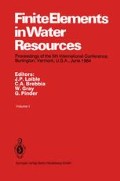Abstract
Usually, by a hybrid method it is understood one in which continuity requirements are reduced or eliminated altogether [Babuska, et al., 1977, 1978; Pian & Tong, 1969; Tong, 1970] by introducing auxiliary dependent variables. Finite element methods for elliptic equations of order 2m, are said to be nonconforming when in the evaluation of the energy, which involves derivatives of order m, the approximations to derivatives of order m-1 may have simple discontinuities [Nitsche, 1974; Strang, 1972].
Access this chapter
Tax calculation will be finalised at checkout
Purchases are for personal use only
Preview
Unable to display preview. Download preview PDF.
References
Babuska, I., Oden, J.T., and Lee, J.K. (1977) Mixed-Hybrid Finite Element Approximations of Second-Order Elliptic Boundary-Value Problems. Computer Methods in Applied Mechanics and Engineering, 11, 175–206.
Babuska, I., Oden, J.T., and Lee, J.K. (1978) Mixed-Hybrid Finite Element Approximation of Second Order-Elliptic Boundary-Value Problems. Par 2. Weak-Hybrid Methods. Computer Methods in Applied Mechanics and Engineering, 14, 1–22.
Herrera, I. (1980) Variational Principles for Problems with Lin ear Constraints. Prescribed Jumps and Continuation Type Restric tions. Jour. Inst. Maths. and its Applics., 25, 67–96.
Herrera, I. (1981) An Algebraic Theory of Boundary Value Problems. Kinam, 3, 161–230.
Herrera, I. (1982) Boundary Methods for Fluids, in: Finite Elements in Fluids, Vol. IV, R.H. Gallagher, D. Norrie, J.T. Oden, and O.C. Zienkiewics, (eds.), John Wiley and Sons, Ltd., Chapter 19, 403–432.
Herrera, I. (1984g)Trefftz Method, in: Progress in Boundary Ele ment Methods, Vol. 3, C.A. Brebbía, (ed.), Springer-Verlag, Chapter. (in press)
Herrera, I. (1984b)Boundary Methods: An Algebraic Theory, Pitman Publishing Co., London (in press).
Nitsche, J. (1974) Convergence of Nonconforming Methods, in: Mathematical Aspects of Finite Elements in Partial Differential Equations, C. de Boor, (ed.), Academic Press, N.Y., 15–53.
Pian, T.H.H. and Tong, P. (1969) Basis of Finite Element Methods for Solid Continua. Int. J. Numer. Maths. Eng., 1, 3–85.
Rose, M.E. (1964) Finite Difference Schemes for Differential Equations. Mathematics of Computations, 18, 179–195.
Rose, M.E. (1975) Weak-Element Approximations to Elliptic Differential Equations. Numer. Math., 24, 185–204.
Strang, G. (1972) Variational Crimes in the Finite Element Meth od, in: Mathematical Foundations of the Finite Element Method with Applications to Partial Differential Equations, A.K. Aziz (ed.), Academic Press, N.Y. 689–710.
Tong, P. (1970) New Displacement Hybrid Finite Element Models for Solid Continua. Int. J. Numer. Meths. Eng., 2, 73–85.
Author information
Authors and Affiliations
Editor information
Editors and Affiliations
Rights and permissions
Copyright information
© 1984 Springer-Verlag Berlin Heidelberg
About this paper
Cite this paper
Herrera, I. (1984). Hybrid Methods from a New Perspective. In: Laible, J.P., Brebbia, C.A., Gray, W., Pinder, G. (eds) Finite Elements in Water Resources. Springer, Berlin, Heidelberg. https://doi.org/10.1007/978-3-662-11744-6_4
Download citation
DOI: https://doi.org/10.1007/978-3-662-11744-6_4
Publisher Name: Springer, Berlin, Heidelberg
Print ISBN: 978-3-662-11746-0
Online ISBN: 978-3-662-11744-6
eBook Packages: Springer Book Archive

